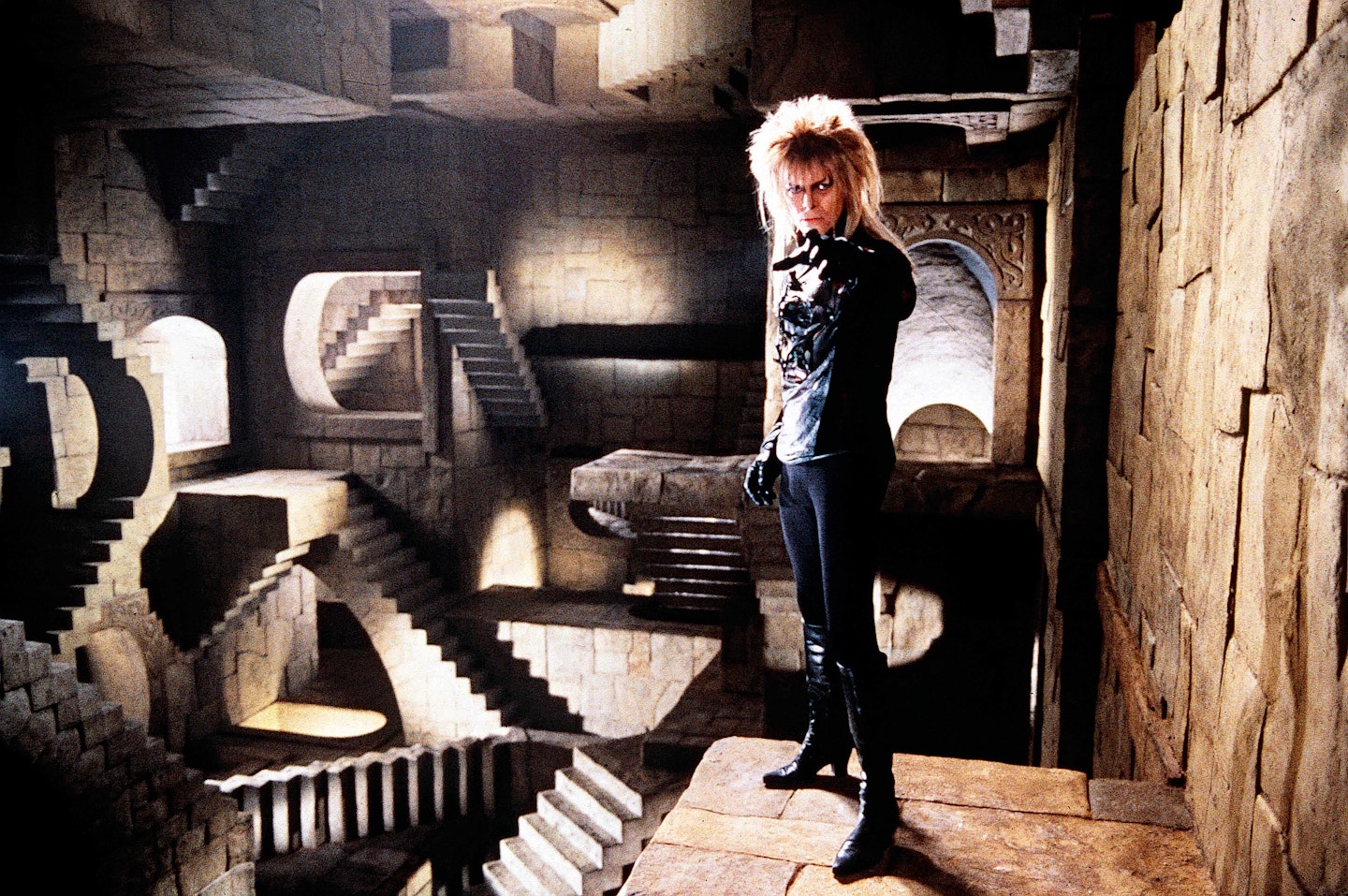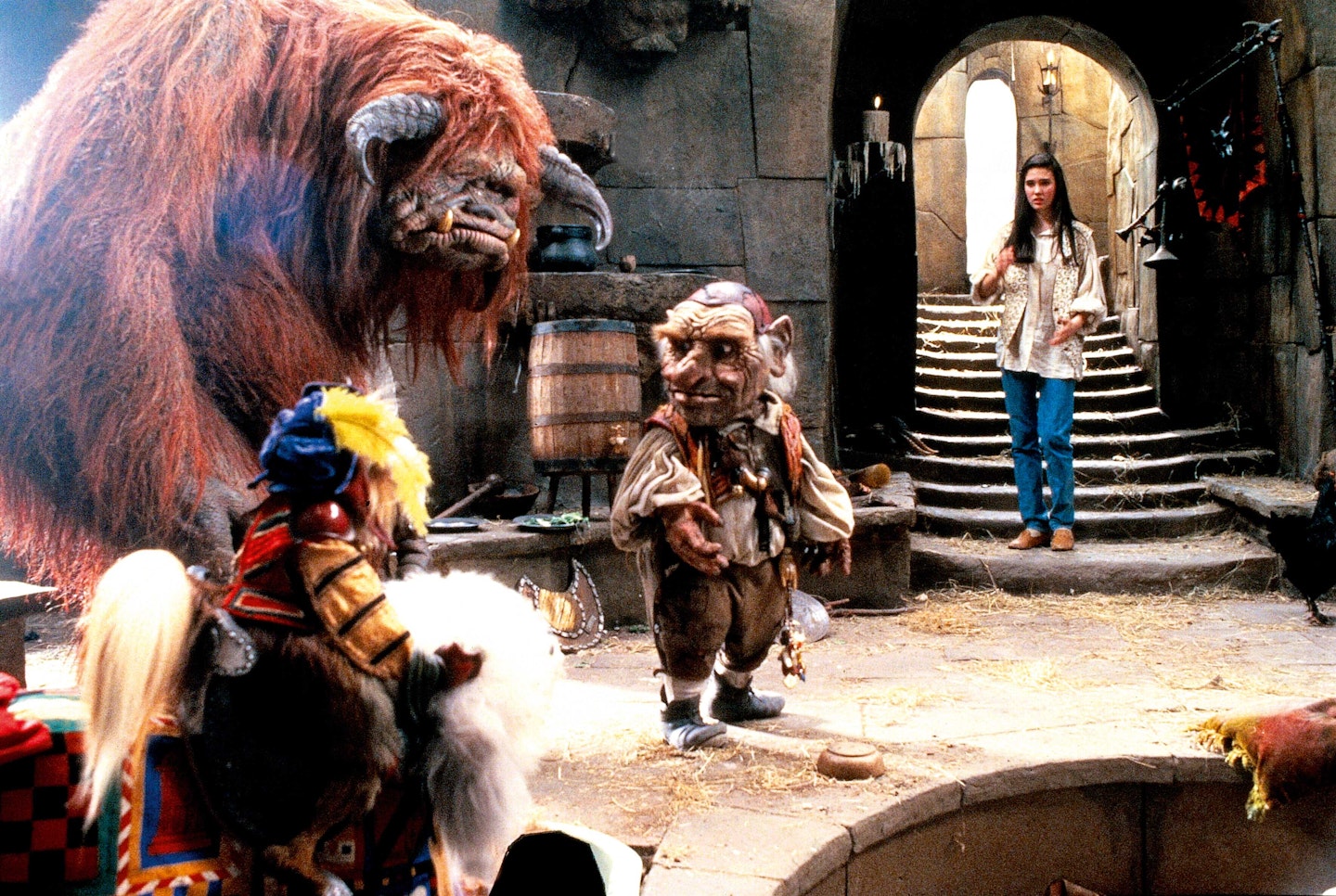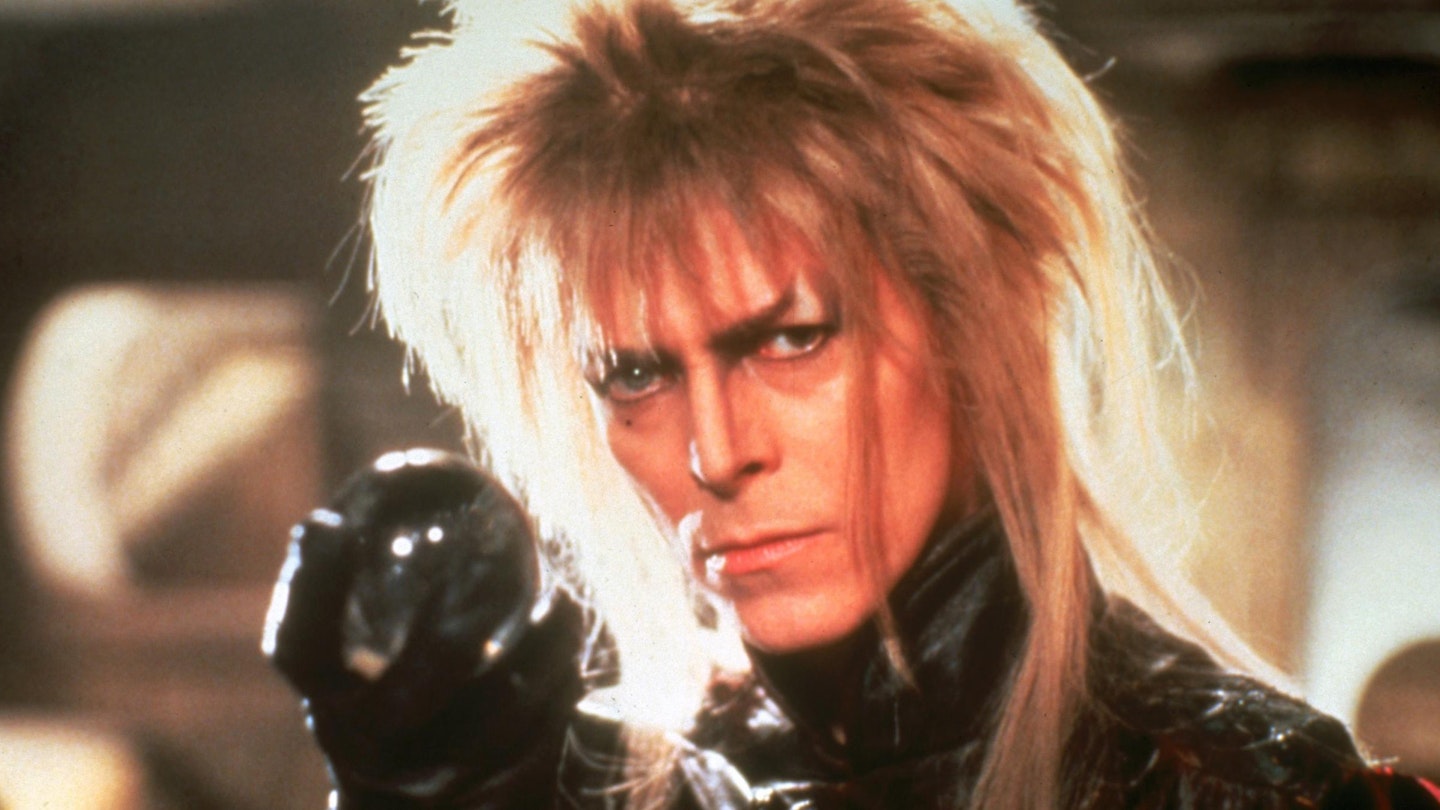For Ovid, the Minotaur-housing labyrinth at Knossos was a maze of “wandering passages” that “framed confusion and seduced the eye”. Herodotus believed the Egyptian Labyrinth on the west bank of the Nile surpassed the Pyramids in its spectacle and ambition: “balling and intricate... an endless wonder.” Jean Luis Borges conceived his stories as labyrinths - cryptic tales in which the reader is tempted down dead-ends of mistaken perception. And Jim Henson’s Labyrinth... is all about goblins and David Bowie’s crotch.
After five years developing and creating the crazily ambitious fantasy The Dark Crystal, all involved might have been forgiven for vowing never again to leave Muppet movie territory. But for Henson, not one to sit back, the question was, “Shall we do another one, then?”
“I felt like I’d made my film and had had enough,” recalls Dark Crystal and Labyrinth’s conceptual artist Brian Froud. “But when Jim suggested working together again, I found myself thinking, ‘Well, why not?’”
Initial suggestions of “something to do with Indian mythology” seemed attractive, given the opportunities for colour and action and flying chariots, until both men realised they knew next to nothing about the subject. “But what flashed into my mind was goblins,” says Froud, “and Jim’s eyes lit up. Then the idea of the labyrinth occurred to me, because the thing about labyrinths is that they can have a metaphorical sense – they don’t have to just be a literal place. They can be something else as well…“

Partly as a retreat from the complexities of the indifferently received and solely puppet Dark Crystal, and partly in recognition of the fact that the Muppets had always achieved success when paired with real people, Labyrinth was immediately conceived as a project that would feature humans among the latex monsters. “That set the whole film really,” Froud says. “I had an instant vision of a baby surrounded by goblins, which I thought would look really striking. In European fairy tales, that’s what goblins do - they steal babies. I painted a picture of a baby surrounded by goblins, and then continued to paint other conceptual things, just ideas for characters. And the story developed from there.”
It’s all over the place but it’s so good in its own way.
Following Frank Oz’s contributions to the Star Wars saga with Yoda, Labyrinth would in turn see George Lucas teaming with Henson as executive producer. “The reality of the art and science of puppets, and trying to create realistic rather than abstract puppets, was really what Jim and I had been working on from the very beginning,” explains Lucas of the project’s attraction. “How can we make these look like real creatures? It’s a struggle because it’s a technological exercise more than anything else. Jim’s ability to combine old puppet techniques with state-of-the-art was his genius. He really understood how to make-believe and then make it real.”
With artistic and character designs underway, the writer initially charged with creating Labyrinth’s narrative was the Canadian poet and children’s author Dennis Lee (who would go on to write most of the lyrics for the songs in Henson TV show Fraggle Rock). Before long, however, the project found its way to Terry Jones.
Coincidentally, Jones had been thinking of getting in touch with Henson anyway. “I was adapting my book, Erik The Viking, into a film, and I thought I’d ring Jim Henson’s office to see if they’d like to do the monsters,” Jones tells Empire. “And they said they’d just been trying to get hold of me the day before! Jim’s daughter Lisa had read Erik and said I might be a good fit for Labyrinth. Jim came round to my house in Camberwell and I remember he couldn’t take his eyes off our dog, which was a long-haired Jack Russell terrier. It eventually became the basis for the knight, Sir Didymus. Mitch The Bitch was immortalised in Muppet form!“
An example of the more obviously Muppety characters that Labyrinth sports in contrast to The Dark Crystal, Didymus was performed by The Great Gonzo himself, Dave Goelz. Unusually, though, the voice belonged to someone else - David Shaughnessy. “Jim did want to stylistically break from the Muppets,” Goelz explains, “and he just didn’t want any of our voices to be recognisable. There are only so many different sounds one person can make. He later told me that the hard part, once the filming had happened with the original temporary voices - our own - was to find another voice that could be slotted in and still work. But I think he did a great job.”
The Bog Of Eternal Stench? Yes, that sounds like me!
Dennis Lee’s work did not much impress Jones, although it did surprise him. “Rather than write a script, he’d written a poetic novella,” Jones recalls with a degree of incredulity, “and he hadn’t actually finished it, so it wasn’t even a complete thing. I can’t remember if Brian Froud had been designing from this novella or not, but I didn’t really get on with it, so I discarded it and sat down with Brian’s drawings and sifted through them and found ones that I really liked, and started creating the story from them. I think the only thing I kept from the novella was Hoggle squirting the fairies. I thought that was funny!”
Yet Jones quickly found that his ideas were not entirely simpatico with Henson’s, and his intention to come up with an environmentalist parable, and to keep the Goblin King off-screen for the entire film before revealing him as a Wizard Of Oz-like charlatan at the end, were politely but firmly declined by the director.
“Jim said he wanted it to be more a young girl’s coming-of-age story,” Jones remembers, “and he wanted to show the centre of the labyrinth sooner, because he wanted to play around a lot there. I really thought we shouldn’t see the centre of the labyrinth before the girl does, otherwise what’s the hook for the audience? The other thing, of course, was that Jim wanted to approach Michael Jackson or David Bowie to play Jareth, and have him sing and appear all the way through. I had to re-write it to fit in with that."
Following Jones’ re-writes, the screenplay passed through other hands - including Ishtar writer/director Elaine May’s - before returning to the ex-Python a year or so later. “Jim said to me, ‘Er, well, I think we’ve messed it up. It’s not funny now - can you do something with it?’” laughs Jones. “So I basically pulled it back to my second draft. I was actually thinking at one point about taking my name off it, but then Jim rang me up and said he’d like to give me sole screenplay credit, and I just couldn’t for the life of me think how to refuse!”

We can only imagine the Michael Jackson Labyrinth, since the role of Jareth the Goblin King ultimately, of course, fell to Bowie, convinced backstage during his 1983 tour by Froud’s designs and a video of The Dark Crystal. Long on the lookout for a project that would allow him to write a whole film’s worth of music for children - “I’d done The Laughing Gnome, so I thought I might as well go all the way!” - Bowie was impressed by a screenplay he found “amusing without being vicious or spiteful or bloody, and with more heart than many other special-effects movies”.
Bowie’s time on set was limited, and he was kept sequestered by a somewhat overbearing PA, but Froud says that their single brief meeting was at least a memorable one. “I met David in his dressing room, and gave him this flute that we’d made out of an animal bone. He leapt up onto the dressing table, with the mirror with the lights round it, and he hunkered down and played it, and he just became this extraordinary Pan-like figure. It was wonderful. But he never did it in the film!“
Froud’s subsequent dealings with Bowie were at a distance, but “my wife Wendy was often at his feet as he was throwing our child around!” (Baby Toby was played by Toby Froud.)
Everyone always talks about Bowie’s perv pants, but there was a reason for it all...
Bowie’s understanding of Jareth was that he was at best a romantic, at worst “a spoilt child, vain and temperamental - kind of like a rock star!” In that way, Jareth embodies both an alter-ego of the similarly bratty Sarah (Jennifer Connelly), who prays for the goblins to take her baby brother away in the first place, and, in a detail that’s sometimes missed, a character cobbled together from Sarah’s adolescent preoccupations.
The idea, Froud explains to Empire, was always that Sarah, reaching the age of sexual awakening, is a lustful fan of Bowie-like rock stars, and therefore creates Jareth in a Bowie-like image. “We’re not looking at reality, we’re inside this girl’s head,” says the artist. “There are references to all sorts of things in his costume. There’s the danger of a leather boy in his leather jacket, which also has a reference to the armour of a certain type of German knight in it; there are references to Heathcliff from Wuthering Heights; and the tight trousers are a reference to ballet dancers. He’s an amalgam of the inner fantasies of this girl. Everyone always talks about Bowie’s perv pants, but there was a reason for it all! It has a surface that’s fairly light, but then every so often you go, ‘Oh, my God! How did we get away with that?!‘”

The majority of the beasts Sarah meets on her quest to recover her brother can be glimpsed before she even enters the labyrinth, as stuffed toys, games, bookends and pictures in her bedroom. Her bookshelves are revealing too – she has copies of Alice’s Adventures In Wonderland, Grimm’s Fairy Tales and Outside Over There by Maurice Sendak, a book that involves a girl who’s jealous of her baby sister, but undertakes a quest to retrieve her when she’s kidnapped by goblins. “Jim was an admirer of Sendak,” says Froud, “but we based Labyrinth on European folklore. We can only assume Sendak was using the same sources. The link between his work and ours was only noticed well into production.” The film’s end credits give a nod to Sendak as a non-specific inspiration.
“It sort of fell between two stools,” Terry Jones says of the film. “It didn’t really end up as the story I wanted to tell, but I don’t know if it was quite the story Jim imagined either. I think I was a bit nervous about how much of what I wrote would end up in the film, but it does mostly resemble my second draft. The hands that help Sarah down the shaft are mine, and the hat that talks back to the old man. The Bog Of Eternal Stench? Yes, that sounds like me!”
“At first I felt the girl was not sympathetic,” laughs Goelz, “but I’d never had a teenage daughter at that time. I didn’t realise that this is a normal thing! Once the film came out, I watched it a few times and I started to really feel what it was about, and now I love Labyrinth. It’s all over the place but it’s so good in its own way.”
“It wasn’t ‘cobbled together’ exactly,” says Froud, “but Terry was writing new scenes very late into production. He kept flicking through my sketchbook and going, ‘Ooh! I like that!’ The door-knockers and the hat were classic examples. Terry just ran with that stuff. It didn’t end up as his whole vision, but it wouldn’t have been the same without him."
Labyrinth is out now on Blu-ray and DVD. This article originally appeared in Empire magazine issue #272 (February 2012).
